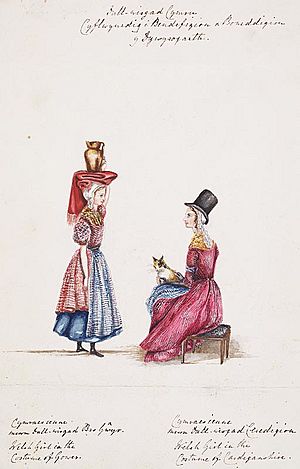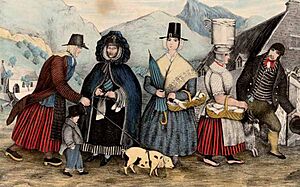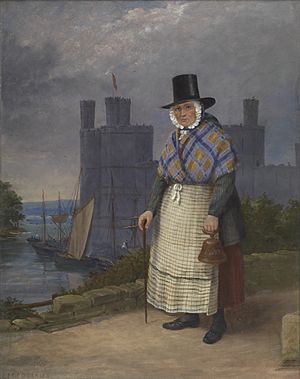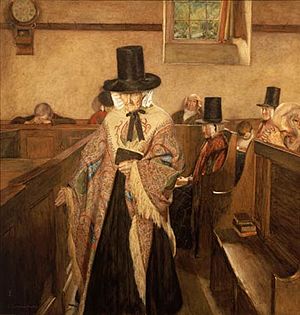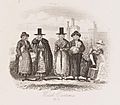Traditional Welsh costume facts for kids
The Welsh traditional costume (in Welsh, Gwisg Gymreig draddodiadol) was a special outfit worn by women in the countryside of Wales. Visitors from England in the late 1700s and early 1800s noticed that it was different from what women in rural England wore. It was probably a style of clothing that working women across Europe used to wear.
This costume included a type of long dress called a gown. This gown was similar to what richer people wore in the 1600s and 1700s, but it stayed popular in Wales for longer. A very special part of the costume was the Welsh hat, which first appeared around the 1830s. By the 1840s, this hat became a symbol of Wales.
The Welsh costume likely started as everyday clothing for rural women, with different styles in different areas of Wales. Over time, it became a traditional outfit. Wives and daughters of wealthier farmers would wear it for special events or when they went to market to sell their goods.
By the 1880s, the traditional costume was not worn every day anymore. However, some parts of it were chosen to become a National Costume. From then on, women wore it for important events like Royal visits, when singing in choirs, at church, for photos, and sometimes at Welsh festivals called eisteddfodau. Girls first started wearing the costume to celebrate Saint David's Day just before the First World War. Today, this costume is known as the national dress of Wales.
Contents
The Story of the Welsh Costume
Not much is known about the traditional Welsh costume before 1770. This is when the first tourists came to Wales. They wrote and drew pictures of the clothes worn by women. These visitors noticed that women in rural Wales wore unique outfits that changed from one place to another. Women in towns or near the border with England often wore English styles, usually made of cotton.
In the 1830s, some important people, like Augusta Hall (later Lady Llanover), tried to save Welsh traditions, including the costumes. She might have asked for drawings of costumes from different parts of Wales. These drawings were not widely shared at the time. They were first published in an article in 1951.
People later thought that Lady Llanover had a huge influence on the Welsh costume. This idea came from an article published in 1963. It made many believe she either invented or saved the traditional Welsh costume. However, there is little proof that she greatly influenced rural women wearing the costume across Wales in the 1800s.
How the National Costume Began
Even though the traditional costume was not commonly worn by the mid-1800s, some women still wore it for markets and special events. People started asking for the Welsh costume to be brought back for big national events, especially when royalty visited.
In the 1840s, Augusta Hall held parties where her friends wore costumes. These were based on fashion plates she might have ordered. However, these party costumes were made of fancy satin, not wool.
The costume became popular as Welsh Nationalism grew. Many people saw the growth of factories in south Glamorgan as a threat to the traditional farming way of life. So, the national costume, made from Welsh wool, became a way to show Welsh identity. During a visit by the Prince of Wales to Swansea in 1881, many young women, including a choir, wore the Welsh costume.
From the 1880s, both old and new versions of the costume were worn by performers at concerts and eisteddfodau. Stall holders at fundraising events and people attending Royal visits also wore them. Only a small number of women wore the costume this way. However, it was special enough to be mentioned in reports of these events. Some of these women might have been younger members of new middle-class families. They could afford the costumes and had time to go to such events.
For some, wearing the Welsh costume after the 1880s was about keeping traditions alive. For others, it was about Welsh identity and nationality. It might also have been a way to stand out from newcomers. This was true both in what they sold at market and because many of them likely spoke Welsh. For a few, it was about promoting traditional businesses, especially weaving. There is little proof that the costume was worn just to please visitors, but it might have happened.
Young women who wore the costume for special events from the 1880s were seen as representing the new Wales. The costume became linked with success. This was especially true after the Welsh Ladies’ Choir, dressed in Welsh costume, won a prize at the Chicago World Fair Eisteddfod in 1893. They then sang for Queen Victoria and performed concerts across Britain.
The Modern Costume
Today, the modern costume worn by girls on St David’s Day can be bought in shops. In the past, mothers often made them from old costumes. The design, colours, and use of lace (which was rare in 19th-century Welsh costumes) might come from outfits made for competitions. This includes those at the International Eisteddfod (started in 1947). Dancers at these events needed a comfortable and practical costume that looked different from those worn by other nations. The costume now worn by dance teams is based on the tailored gowns originally found in southwest Wales.
Parts of the Welsh Costume
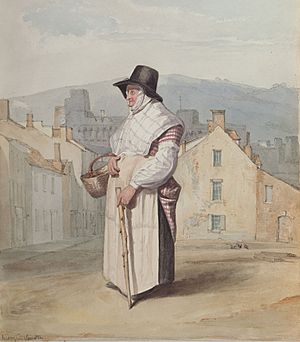
Main Pieces
The Gown or Bedgown
The most unique part of the Welsh costume, besides the hat, is the gown. It is often called a bedgown. In Welsh, it is usually spelled betgwn. There were two main types:
- A fitted style with a low-cut top and a long, wide tail. These were common in Cardiganshire (Ceredigion) and Carmarthenshire. They were often made of striped flannel in red and dark blue or black. A shorter version in plain fabric was found in Pembrokeshire.
- A loose, T-shaped style, like a kimono. This type was found in northwest and southeast Wales. These were often made of printed cotton.
The Skirt and Underskirt (Pais)
These were usually made of heavy flannel. They had vertical or sometimes horizontal stripes in bright colours, often reds and dark blue or black and white.
The Cape or Mantle
These were long and often had large hoods to cover the Welsh hat. Blue woollen cloaks were much more common than red ones in most of Wales.
The Shawl
Many different kinds of shawls were worn in Wales:
- Square Shawl: A square wool shawl in natural colours with a fringe. It was folded into a triangle or rectangle and worn over the shoulders.
- Turnovers: Some finer printed shawls were made so that when folded diagonally, both sides of the edges looked right-side up.
- Whittle: Large rectangular or square woollen shawls with long fringes. They were worn around the waist to carry food. Sometimes they were worn over the shoulders like a cape. Many were white or cream, and sometimes red. They seemed more common in South Wales. A small red wool version was worn around the shoulders in North Pembrokeshire. It is said women wore them when they helped fight off the French during the Last invasion of Britain.
- Nursing Shawl: A large square shawl with long fringes, made of natural white or cream wool. It was worn around the shoulder and waist to hold a baby. This freed the mother's hands for other tasks. These were mostly in South Wales.
- The Paisley shawl: Medium to large shawls made of wool, silk, or printed cotton. They had bright Paisley patterns. Many had fringes. Even though people think these were a key part of Welsh costume, most were expensive. They were probably only worn for very special occasions.
The Handkerchief
Sometimes called a fishu, this was a square piece of fabric. It was usually printed cotton or linen. It was worn around the neck and tucked into the top of the gown. Sometimes it was worn over the head like a scarf.
The Apron
The apron was often in natural colours (white, cream, grey, or black) with checkered patterns.
Many women spent a lot of time knitting stockings. However, most were sold to other countries. Before about 1850, many rural women walked barefoot to and from market. Some wore stockings that did not cover their feet.
The Cap
Also known as the mob cap, this was a head covering made of linen or cotton. It had folded fabric around the face. Some had long pieces that hung down the front, below shoulder level.
The Welsh hat
The Welsh hat is special because of its wide, stiff, flat brim and tall top. There were two main shapes for the top:
- Drum-shaped tops were worn in northwest Wales.
- Slightly tapering tops were found in the rest of Wales.
They were probably first made of felt. Most hats that still exist are made of silk plush on a stiff base. A third type of hat, called the cockle hat, was worn in the Swansea area.
Men's Costume in Wales
The clothes worn by men and boys in Wales were rarely drawn or described. This is because they were very similar to what men in England wore. They included a waistcoat (often bright), a jacket (usually blue or grey wool), a neckerchief, breeches (short trousers), woollen stockings, and a black felt hat. The hat was either like a bowler hat or one with a low, drum-shaped top and a wide, soft brim.
Gentry Costume in Wales
Most wealthy people (gentry) wore the newest fashions. They bought these clothes from agents in Paris and London. Or they bought them from local tailors who read about the latest styles in newspapers.
How We Know About the Costume
Written Descriptions
Over 40,000 words were written describing Welsh costumes in the 1700s and 1800s. Most of these were by English middle-aged, middle-class men. However, descriptions by women tend to be long, detailed, and likely accurate. There are few descriptions in Welsh or by Welsh people writing in English. Almost no records have been found about what the women who wore the traditional costumes thought of them.
What was written about Welsh costume was often shaped by what the observer expected. Many visitors to Wales in the late 1700s were looking for beautiful, natural places. This might have influenced what they wrote down. They were often happy to find that many women they saw were healthy, happy, and pretty. They also wore clothes that were clearly different from those of English maids.
Pictures and Photographs
There are about 700 images from 1770 to 1900 that clearly show Welsh costume. There are also many early 1900s photographs, mostly postcards. Some of these were based on older photos, while others were funny. Many of these images of Welsh costume were sold as souvenirs of Wales. They helped keep the idea that Welsh costume was unique. Most photographs were "staged" by the photographers. The women often wore their own old costumes or borrowed some from the photographer.
Surviving Costumes
A few Welsh costumes still exist in museums and private collections. Most are kept at the St Fagans National History Museum near Cardiff and the Ceredigion Museum in Aberystwyth. It is very hard to know exactly when they were made. The origin of the fabrics is often unknown.
Dolls
About eighty 19th-century dolls dressed in Welsh costume are known. Many have real Welsh costume fabrics, which might be the oldest surviving fabrics of their kind. Almost every female member of the Royal family since Princess (later Queen) Victoria visited in 1832 was given a doll dressed in Welsh costume when they came to Wales. This shows that even then, the Welsh costume was seen as something special. It was also being sold along with costume prints.
Gallery
Images for kids
See also
 In Spanish: Indumentaria tradicional de Gales para niños
In Spanish: Indumentaria tradicional de Gales para niños



